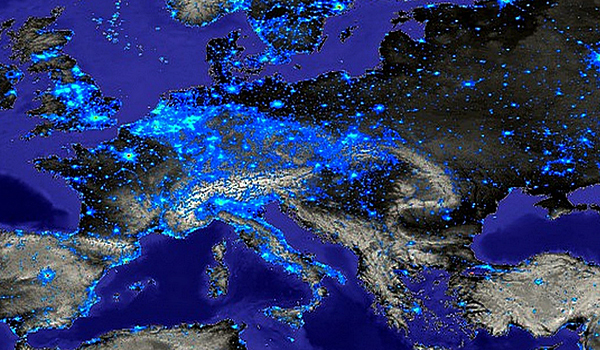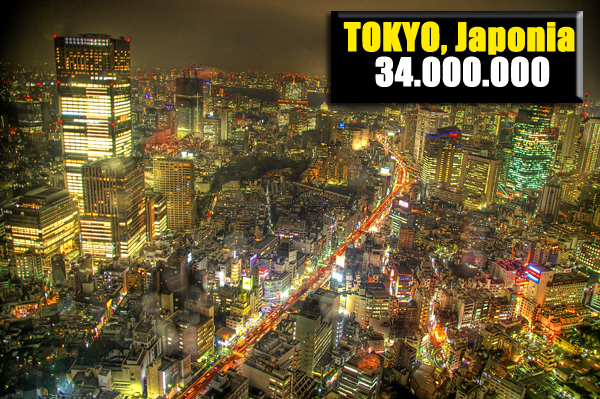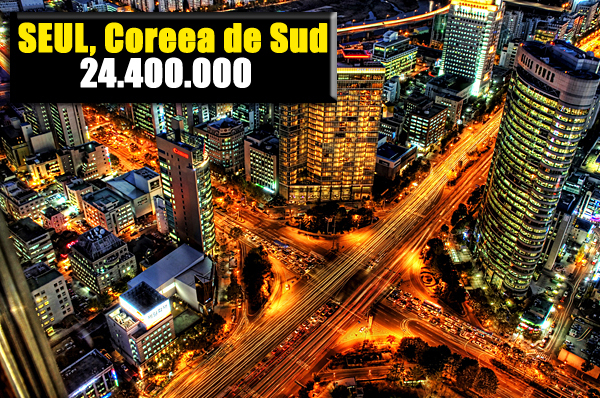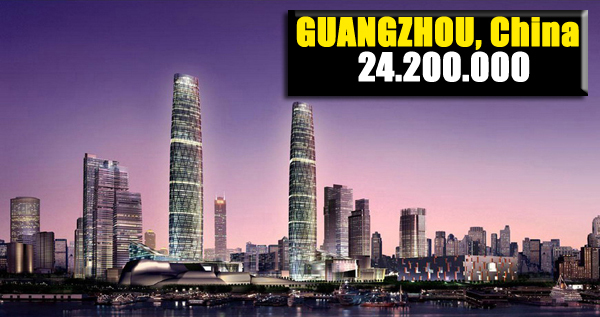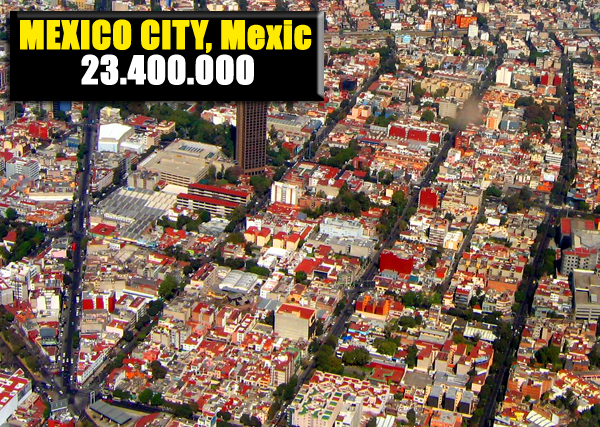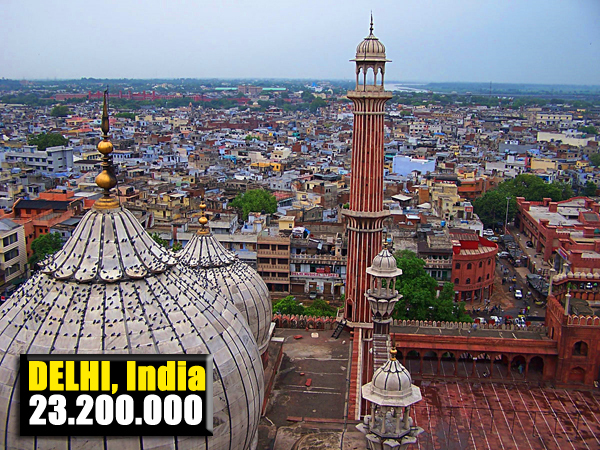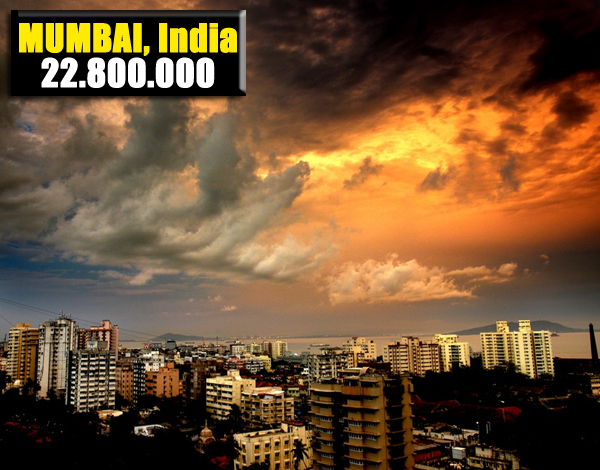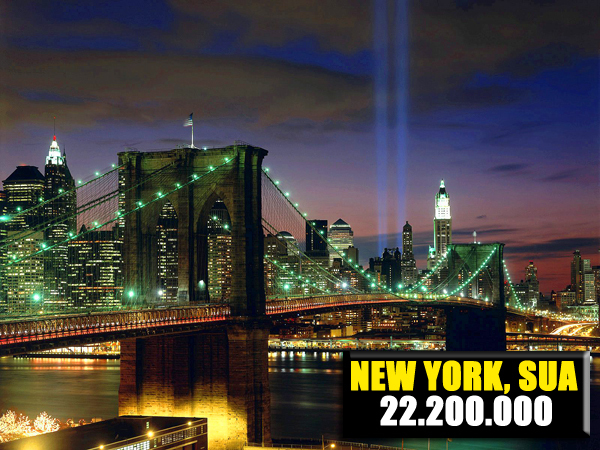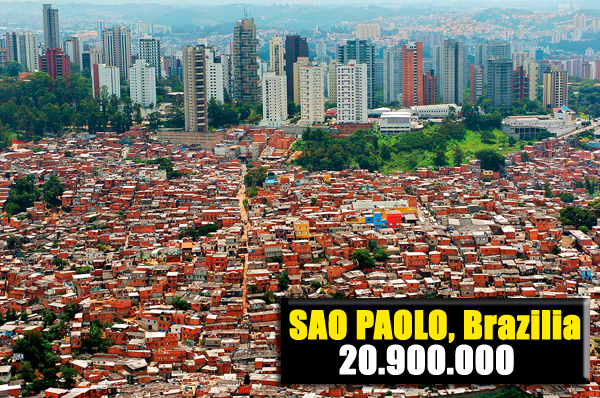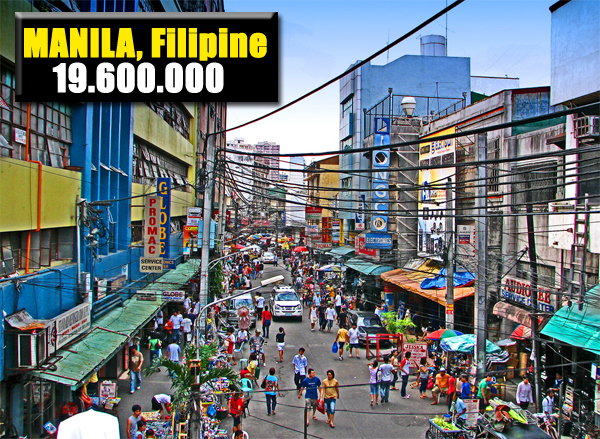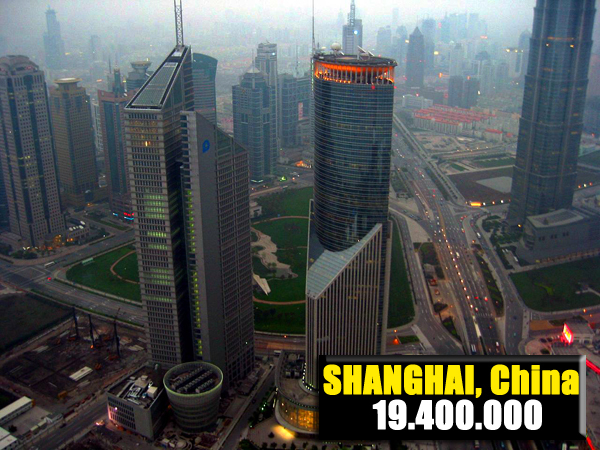People everywhere are building every week the equivalent of a city the size of Vancouver's. It is a statistic from a large study that says that by 2030, will reach major cities in the world have huge areas to cover in full a small state. The tone was already given ...
Simply look at the data on this population in megalopolisurile planet, a population that sometimes exceeds the average size of European countries. Nobody knows where, when or if this trend will stop.
Scientists can only estimate the population growth of these urban mammoths genuine but, as happened not once, figures can be easily disproved. In the same vein, the editors will invite today Descopera.ro a journey, based on updated data in 2010, the largest urban agglomerations of the world ...
1.Tokyo, Japan - 34 million inhabitants
Japan's capital is by far the largest urban agglomeration of the Earth. With its 34 million inhabitants, the population of prefectures including Yokohama, Kawasaki and Saitama, near Tokyo surpasses 10 million souls city ranked in the top two. And the figures to describe the huge urban conglomeration does not stop there. Tokyo covers an area of 2187 square kilometers, nearly 10 times more than Bucharest, is considered the world's most expensive city for expatriates and also is ranked among the top three cities of the world standard of living. Meanwhile, Tokyo is one of the most powerful economic centers of the world, with a purchasing power parity U.S. $ 1.48 trillion. Also in the Japanese capital and seat of government was, Imperial Palace and the residence of the Japanese imperial family.
2.Seul, South Korea - 24.4 million
A giant ant, thus can be characterized Seoul, the city with an incredible density of population, 17,288 inhabitants per square kilometer. Considered the 6th economic center of the planet, according to the prestigious Forbes magazine, host of huge corporations (Samsung, LG, Hyundai), the most expensive city in Asia and the third of the world, Seoul is also the owner of a population whose number exceeds, for example, total population, 24.4 million people. Obviously, in the case of Seoul, were added and the inhabitants of neighboring districts: Bucheon, Goyang, Incheon, Seongnam and Suweon.
3. Guangzhou (Canton), China - 24.2 million inhabitants
Official Canton, Europeanized by name after the Portuguese province of Guangdong, is the largest city in southern China and the third of the country after Beijing and Shanghai. However, if we add the population of the districts of Dongguan, Foshan, Jiangmen and Zhongshan, and that of the delta in southern city, the number of inhabitants reaches a fabulous sum ... over 24 million, enough to propel Canton ranked in the top three most populated cities in the world. Because of this, Guangzhou (City of Flowers) and fabulous this huge city's Olympic Stadium would have to be proposed to host the 2008 Summer Olympics. Only a late decision by the Chinese government has made Beijing the proposed city to be candidate for organizing the Olympic Games.
4. Mexico City, Mexico - 23,400,000 inhabitants
Only 3 million inhabitants include Mexico City (Ciudad de Mexico) in 1950. Nobody envisioned then, probably only that more than six decades, the capital of Mexico was to become one of the most populated urban centers of the world. Basically, today, including districts Nezahualcoyotl, Ecatepec and Naucalpan, Mexico City, reaches the astounding figure of 23.4 million inhabitants. The remarks is the fact that Mexico City gather more than a fifth of the total population of 111 million inhabitants of Mexico. It is certainly both the most populous city in Central America and South America and beyond, as economic power, highly industrialized countries such as Taiwan or Iran. Data provided by Forbes say that Mexico City is a place worthy of a top eight in the richest city in the world.
5. Delhi, India - 23.2 million inhabitants
Along with neighboring districts: Noida, Gurgaon, Greater Noida, Faridabad, New Delhi and Ghāziābād, Delhi has managed to beat Mumbai by almost 400,000 people, and become the 5th city in the world in number of inhabitants. Approximately 23.2 million people live in Delhi, one of the largest cultural centers of India's political and commercial. The city hosts, among others, Parliament of India, New Delhi and the district was made the capital of the country in 1947, with India gaining independence from Britain.
6. Mumbai, India - 22.8 million inhabitants
With a total population of 22.8 million inhabitants, of which 13, 8 million live in its urban area called (the rest can be found in districts Bhiwandi, Navi Mumbai, Kalyan, Ulhasnagar and Thane), Mumbai, capital of Indian state of Maharastra , was declared the richest city in India. Higher standard of living of the city, far more than India's overall average, annually attracts hundreds of thousands of people from all over the country, which makes Mumbai one of the truly cosmopolitan cities of the world. Also in Mumbai, with prestigious financial institutions (National Stock Exchange of India, Bombay Stock Exchange or the Reserve Bank of India) was added and the center of Indian film industry, Bollywood ...
7. New York, USA - 22.2 million inhabitants
Metropolitan area of New York is by far the most populous in the United States of America, surpassing Los Angeles with nearly five million inhabitants. Lenape Native American House, then the gate of immigrants to the New World, the city formerly called New Amsterdam has grown one of the largest urban centers in the world with a population of 22.2 million inhabitants, a figure that adds incredible density of 17 400 inhabitants per square kilometer. New York is also a symbol of American capitalism, freedom and democracy of the North American. Statue of Liberty, Times Square, Broadway, Wall Street, Chinatown, Brooklyn Bridge, Mahatannul or prestigious universities of Columbia and New York are just some of the symbols of American Megalopolis.
8. Sao Paolo, Brazil - 20.9 million inhabitants
Who Does not heard of Sao Paolo, Brazil's largest city, the richest urban center in the southern hemisphere of the planet and the 8th city in the number of people in the world? Well, Sao Paolo, Brazil huge city, to gather in the metropolitan area not less than 20.9 million inhabitants of the 192.3 million citizens of Brazil. Known for its unique architecture, the many skyscrapers, festivals, carnivals and annual exotic huge size of its fleet of helicopters, giant Sao Paolo has a motto that no longer leaves room for further interpretation: "Non ducor, Duco! - I am not led, I lead!
9. Manila, Philippines - 19,600,000 inhabitants
Not more than 16 cities and municipalities make up the metropolitan area of Manila, the Philippines and the capital city of the world's busiest. 43 079 inhabitants per square kilometer, a total population of 19.6 million inhabitants, plus the number over a million tourists annually visiting the anthill in Southeast Asia. Named Pearl of the Orient since European settlers first time, Manila was called the Far East in May, a paraphrase of the Far West-North American site. Medieval Fort Santiago, Rizal Park, Cultural Center, Malacañang Palace Manila Cathedral and represents some of the biggest attractions of the Philippine capital.
10. Shanghai, China - 19.4 million inhabitants
It's basically the biggest city in scope, China's most populous and one of the world. With a population that tends to 20 million inhabitants, Shanghai is still rising, from this point of view, at breakneck speed and threatens megalopolisurilor positions on top of the charts. Urbe originally intended and the fishing industry of weaving, Shanghai has experienced an economic boom unparalleled in Chinese history with the opening in 1842, foreign traders and port or due to the favorable position. Today, the city is the largest financial center in mainland China and one of the most popular tourist destinations in this part of the world. Over 1 million people worldwide business substituted for the number of Chinese residents, with nearly 5 million Chinese from neighboring prefectures: Anhui, Jiangsu and Zhejiang.
Facts:
- The first European city in a top of the most populated cities in the world is Moscow, with a population estimated at 01.01.2010, at 13.6 million inhabitants. Even so, Moscow would not be the situation than the 17th position.
- The second European city in the number of inhabitants, Istanbul, not deal with the 21 position than the 12.8 million inhabitants.
- Bucharest ranks 200 with a total population in the metropolitan area of about 2.2 million inhabitants.
- No other Romanian city is not listed in one of the top 500 most populated cities in the world.
- Romania's population totals approximately 21.5 million inhabitants.
 His beautiful color - rare among metal - and his wonderful glow are most likely the first qualities that have attracted people to gold since prehistory. And using it, they found the weather and other qualities, thanks to which they valued more, for millennia. Until today, gold continues to be highly valued in both art and science because of its remarkable properties. At first, it was perhaps that could be valued for easy processing: from pieces of native gold (found as such) could be reached fairly quickly ornaments: gold can be processed easily, even cold, even with of primitive tools. This property, called malleability, made possible to obtain the most beautiful jewelry, but also the most sumptuous gilded decorations.
His beautiful color - rare among metal - and his wonderful glow are most likely the first qualities that have attracted people to gold since prehistory. And using it, they found the weather and other qualities, thanks to which they valued more, for millennia. Until today, gold continues to be highly valued in both art and science because of its remarkable properties. At first, it was perhaps that could be valued for easy processing: from pieces of native gold (found as such) could be reached fairly quickly ornaments: gold can be processed easily, even cold, even with of primitive tools. This property, called malleability, made possible to obtain the most beautiful jewelry, but also the most sumptuous gilded decorations.  Gold is very malleable and ductile of the metals . Due to the extraordinary malleability (ability to withstand high compressive forces, which manifests itself can be stretched into sheets without breaking), gold can be beaten by a fine foil incredible: a single gram is obtain a thin film, translucent, with an area of 1 square meter! Ductility is seen in the possibility of being drawn into wires - the wires that can be obtained are thinner, the metal is more ductile. Delicate gold jewelry wire, sometimes true gold wirelace, can be made because of metal ductility. Gold is one of the most dense metals - or of the hardest, as they say in familiar language, is heavier than lead, which has a density of 11 340 kg/m3, while gold is 19 300 kg/m3. (The heaviest metal, the highest density is osmium - 22 610 kg/m3).
Gold is very malleable and ductile of the metals . Due to the extraordinary malleability (ability to withstand high compressive forces, which manifests itself can be stretched into sheets without breaking), gold can be beaten by a fine foil incredible: a single gram is obtain a thin film, translucent, with an area of 1 square meter! Ductility is seen in the possibility of being drawn into wires - the wires that can be obtained are thinner, the metal is more ductile. Delicate gold jewelry wire, sometimes true gold wirelace, can be made because of metal ductility. Gold is one of the most dense metals - or of the hardest, as they say in familiar language, is heavier than lead, which has a density of 11 340 kg/m3, while gold is 19 300 kg/m3. (The heaviest metal, the highest density is osmium - 22 610 kg/m3).














